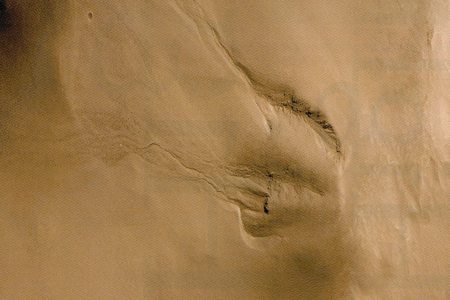
Space Exploration- Mission to Mars
Issue 4 Mar / Apr 2004
Contemporary space exploration is a far cry from the days when people thought that the sun and the moon were the limits of heaven. As Faheem Padia explains, it is only recently that this perception has expanded as the solar system and scattered systems beyond were discovered.
The Qur'an has long since stated, ‘(The heavens) hath seven gates, and each gate hath an appointed portion’ (15:44)
In December 2003 the £50 million Beagle Mars probe completed a six-month long journey spanning 250 million miles to come tantalisingly close to its final destination. Having detached itself from the mother ship Mars Express, Beagle 2 embarked upon a six day descent to the dusty surface of the red planet, only to be lost and never heard from again. It was thwarted before it could begin its task of collecting soil samples and taking environmental readings over the next six months.
The bitter disappointment felt by the scientists behind the European-backed project was compounded momentarily when days into the new year, the US lander Spirit touched down on Mars, yet it too went silent on its first mission. Mars Express is faring a little better and currently negotiating a series of elliptical sweeps over the poles of the planet, surging to within 275km at its closest, and then swinging away to a distance of more than 11,000km as it relays its data back to Earth. The high resolution stereoscopic camera on board is enabling scientists to map the surface of the planet as never before, and to build up a three-dimensional picture of the planet's topography. It has begun to view the planet's surface in intricate detail, photographing mesas and cliffs and even the marks left on them by water, including scouring caused by a vanished watercourse.
In the Qur'an (36:40) it is revealed ‘It is not for the sun to overtake the moon, nor doth the night outstrip the day. They float each in an orbit,’ but the rest of the heavens is largely left a mystery for us.
The European mission to Mars has found the first hard evidence of water on the planet, a discovery which raises questions about the possibility of life on other planets – something which has pre-occupied astronomers for decades. The discovery is due to sophisticated instruments being able to identify the signature of water ice trapped amid frozen carbon dioxide over the Martian South Pole. Theories pointing to water in the polar icecaps were given added weight when an American spacecraft used indirect methods to detect its presence three years ago. But Mars Express has confirmed the find directly and begun the first detailed examination. Another set of sensors has begun to measure the faintest traces of water vapour and ozone in the upper atmosphere. A third has begun to “feel” 5km below the surface, looking for permafrost, aquifers or even underground rivers.
There has been some discussion that Surah Al-Rum (30:22) of the Qur’an denotes the existence of plural worlds by referring to the Creations of heavens.
“And among His Signs is the Creation of the heavens and the earth, and the variations in your languages and your colours.”
Life in Mars has been suggested, written about and debated for many years. The idea had been quashed when no evidence was available to back it up but recent developments have caused hopes once again to be raised. In 2000 the interior of a 1.2 billionyear- old golf ball-sized Martian rock known as the Nakhla meteorite that had landed in the Egyptian desert in 1911 was found to contain water-soluble ions, or charged particles. The chemicals were in the form of carbonates (carbon containing materials). They are thought of as the ‘signature’ of all known life forms.
Bookmark this |
|
Add to DIGG |
|
Add to del.icio.us |
|
Stumble this |
|
Share on Facebook |
|
Share this |
|
Send to a Friend |
|
Link to this |
|
Printer Friendly |
|
Print in plain text |
|


Comments
0 Comments